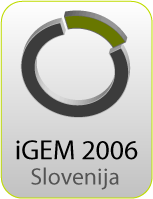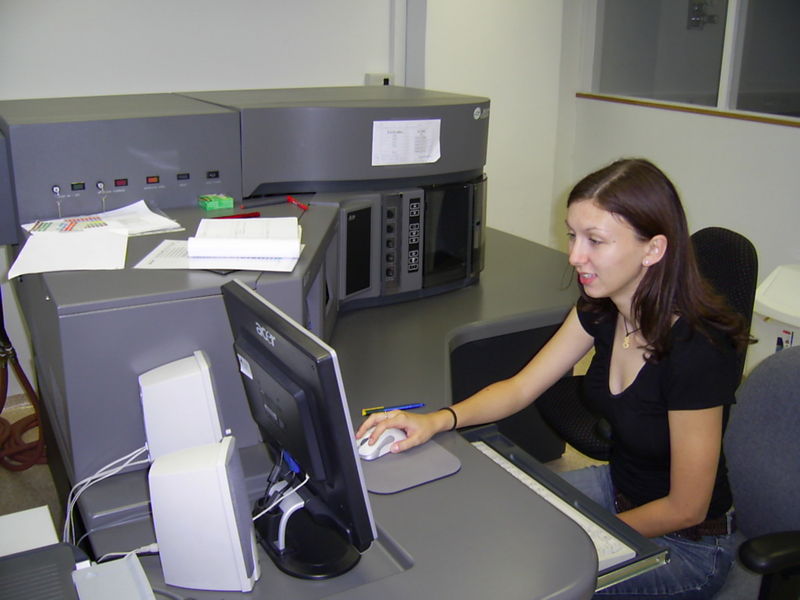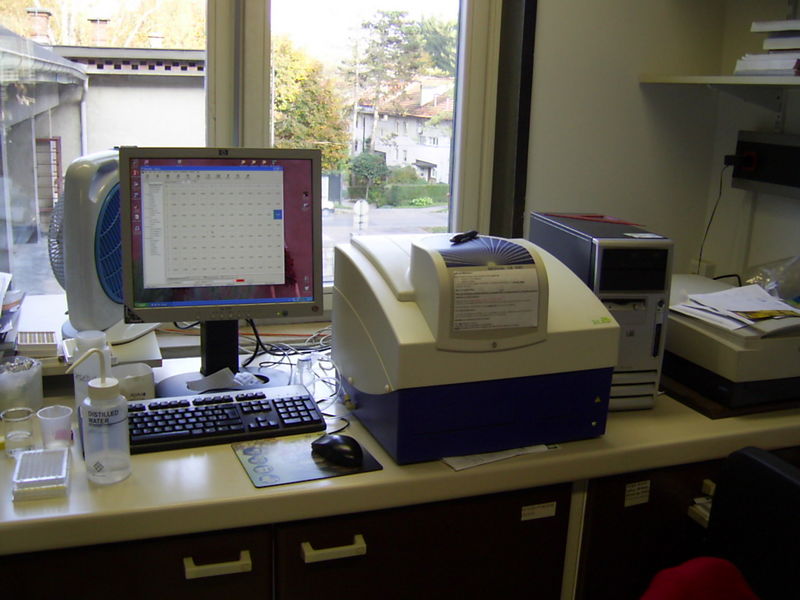Ljubljana, Slovenia 2006/Methods
From 2006.igem.org
| Home | Background and Signalling Pathway | Project & Model | Results & Conclusions | Terms & References | Team members |
|---|
Contents |
Parts design
At first we had to design primers to replicate a desired DNA fragments. In primers we included restriction sites - on left site XbaI and on the right site SpeI, NcoI and PstI. We cloned that part into BioBrick plasmids with ccdB domain to get all restriction sites needed for BioBrick assembly. We had to design all parts de novo, since no parts like promoters, terminators, desired proteins for signaling pathway modification, degradation flags and reporters had been designed so far - neither to work in mammalian cells. List of desired constructs is shown below. For our use we designed a special vector ([http://partsregistry.org/Part:BBa_J52017 BBa_J52017]) with terminator to simplify constructs assembly. All our composite parts (promoter plus part) were then cloned in this vector.
We also needed fusion proteins e.g. dnMyD88-rLuc-PEST ([http://partsregistry.org/Part:BBa_J52013 BBa_J52013]) - that is our dominant negative protein linked with reporter and degradation flag. This parts are designed like basic parts - not composite, although they are fusion proteins. Between proteins there is a six aminoacid long linker because only two aminoacid long linker formed during biobrick assembly could affect protein folding. We introduced a six amino acids long linker inbetween protein - reporter and reporter - degradation flag with primers using PCR Overlap Extension method. These parts were then combined with promoter (NF-κB) in BioBrick assembly technique. The part was then inserted into the vector with terminator and ready to use in human cells (HEK293).
Experiments on mammalian cell cultures
In September and October we were transfecting our constructs into human embrional kidney cells (HEK293). At the same time we were optimizing three detection systems mentioned below. At first we had to optimize the methods (read articles, test negative and positive controls) and learn how to work with human cells.
Cells were transfected not only with our constructs but also with TLRs which are not natively present on the surface of HEK293 cells (only TLR3 and TLR6 are present).
Pathogenic Gram-negative bacteria are the main cause of sepsis. Their outer membrane contains LPS (lipopolysaccharide) that is recognized by TLR4 and MD-2 accessory molecule. - this part doesn't fit into context {Marko, 26.10.}
First, we transfected all HEK293 cells with our constructs and with two additional plasmids coding for TLR4 and the accessory MD-2 protein. Very soon, we found out that our plasmid preparations were contaminated with LPS from E. coli (strain DH5α used for plasmid preparation), since there was no difference in the response between stimulated (with LPS) and unstimulated cells. To overcome this problem we decided to focus on TLR5 receptor which reacts upon contact with bacterial flagellin. Signal transfer through TLR5 does not depend on the presence of LPS.
Detection systems
In order to monitor the activbation of the signaling pathway and function of our Parts we considered using several detection systems. We expected as the result the synthesis of dominant negative protein (MyD88 or TRAF6), blocking of signaling pathway and consequently transcription termination of dominant negative protein. The constructs (parts) we prepared were designed for each detection system respectively.
Requests for the optimal detection system were:
- velocity;
- sensitivity;
- paralelization;
- optical signal would be preferred for the ease of data collection;
- in vivo and real time detection as a bonus;
- low price per assay.
On the basis of those requests we have decided for the following detection systems: flow cytometry, luminometry and ELISA. Members of the team in charge for each detection system are :
Constucts used in individual detection system and short description of detection systems:
Flow cytometry
Used composite parts: NFκB-MyD-Luc ([http://partsregistry.org/Part:BBa_J52014 BBa_J52014]).
Flow cytometry is a sophisticated method, which gives very precise and highly valuable results. The main advantage of this method is that measurements are done on individual cells, so the results are not the average value of the population. In our project we could detect cellular activation based on the phosphorylation cascade activation and anti-phosphoprotein antibodies. In our experiments we used primary antibodies (Ab) from mouse, which specifically detect only phosphorylated form of ERK kinase (pERK). The secondary antibodies used were anti-mouse Abs labelled with a fluorescence marker phycoerithrin (PE), which we can detect on flow cytometer. Cells were transfected with TLR5 or TLR4/MD-2 and with or without dnMyD88, which is under NF-κB promoter. On the second day the cells were stimulated with flagellin or LPS (depends on the selected TLR receptor). According to the literature phosphorylation of ERK can already be detected after 15 min. The amount of pERK increases for additional 20 min and then it starts to decline. After 40 min no pERK is detected.
We used pulsed stimulation of cells. First we stimulated cells with 5ng/ml of flagellin to activate the expression of dnMyD88. We repeated the stimulation with the second, stronger stimulus (50ng/ml of flagellin) at different time intervals (2, 4, 6 and 8 hours after the first stimulation. 30 min after the second stimulus cells were fixed in 2% paraformaldehid, permeabilized with ice cold methanol and stained for pERK and secondary Ab labelled with PE.
Expected results: The activation of the signaling pathway also activates the expression of dominant negative protein MyD88, which should block the signaling, so we expect to detect decreased amount of pERK after second stimulation in comparison to cells without of inducible dnMyD88.
Luminometry
Used composite parts: NFκB-MyD-luc ([http://partsregistry.org/Part:BBa_J52014 BBa_J52014]), NFκB-MyD-luc-PEST([http://partsregistry.org/Part:BBa_J52024 BBa_J52024]), NFκB-luc-PEST([http://partsregistry.org/Part:BBa_J52023 BBa_J52023]), CMV-luc([http://partsregistry.org/Part:BBa_J52038 BBa_J52038]) and CMV-luc-PEST([http://partsregistry.org/Part:BBa_J52039 BBa_J52039]).
Luminometry is a very used method to measure activation of signaling pathways. In many cases it replaced ELISA because it is much more sensitive. The basis of the method is the measurment of light, which is emited after substrate cleavage. We used two different enzymes (firefly luciferase - fLuc and renilla luciferase - rLuc), which recognize and cleave different substrates, so we can measure the activity of both in one sample.
Different variants of the method were used:
1. To be able to measure the activation of dnMyD88 expression after stimulation, we prepared dnMyD88 construct under NF-κB inducible promoter in the fusion with rLuc (construct NF-κB-MyD-luc). We transfected cells with TLR receptor plasmid, biobrick and fLuc under NF-κB promoter plasmid as a positive control. Cells were stimulated and the expression of luciferases was measured in time intervals. We expect that amount of rLuc will increase in time only if cells are stimulated with a ligand.
2. CMV-luc-PEST biobrick was constructed to measure the kinetics of degradation of proteins in fusion with PEST. Cells were transfected with the construct, which is under constitutive promoter. We found out that it takes four hours after the transfection to detect luciferase activity. To calculate half-life of rLuc and rLuc-PEST we transfected cells with those two constructs, incubated to allow proteins to sythesize. New protein synthesis was inhibited by adding cycloheximide and in time intervals the activity of rluc was measured. Because the addition of cycloheximide stops the sythesis of new proteins after time there should be a decrease in rLuc activity due to protein degradation. A construct with PEST should decrease more rapidly as rLuc alone.
3. The main experiment was....
ELISA
[[Image:NF-κB-ELISA.jpg|200px|right|thumb|Figure 3: Schematic representation of the detection of free NFκB, which can bind to the promoter sequence.]]
Used composite parts: NF-κB–dnMyD88 ([http://partsregistry.org/Part:BBa_J52036 BBa_J52036]) and NFκB–TRAF6–GFP ([http://partsregistry.org/Part:BBa_J52022 BBa_J52022]).
With ELISA detection system we can detect the free NFκB transcription factor, which is one of the most direct measurements of the pathway activation. Active form of this protein is present after the activation of signaling pathway when the protein is released from the complex with IκB inhibitor. Free NFκB migrates into the nucleus where it acts as a transcription activator. We are using high bind 96-well plates coated with [http://en.wikipedia.org/wiki/Streptavidin streptavidin](we prepare it ourselves). The probe for free NF-κB is biotinylated double stranded NF-κB binding sequence. The NF-κB protein from whole cell lysate is captured by a probe, whose biotin group binds to the streptavidin coated on the plate. We detect NF-κB with primary mouse antibodies and secondary peroxidase-conjugated rabbit anti-mouse antibodies. Peroxidase cleaves the substrate which emits light, which we measure on the luminometer.
Problems and Troubleshooting
Construction of Parts using bad oligos
We can only suggest to the other teams in the future to order oligos from a reliable and well established company (not necessarily the lowest price). When we repeatedly failed to produce PCR products it could have been the beginner's bad luck but when we determined a huge number of point mutations in the primer region even the mentors decided that we should better avoid this company in the future (although they offered us the replacement of oligos for free). There'll be no next time for this company (from one of our neighboring countries).
Folding question
Does the linker allow efficient & undependent folding of both fusion parts?
Expression levels
Are low signals due to low expression levels of recombinant proteins in human cells? Is low expression a result of low efficient cell transfection?
Luminometry
We have attempted to monitor "real time" cell activation using luminescence. We could not measure luminescence in vivo since coelentrazine decays too quickly, while the luciferin could not penetrate the cells.
Optimization of activation intervals
Much od lab work (more than initially planned) was devoted to the optimization of cell activation. We had to find out the optimal concentration of inducers, timespan between the first and second activation, lenght of experiment in which difference between genetically engineered and wild-type cells would be sufficiently prominent etc. Methods from the literature could not simply be adopted into our experimental procedure.
| Home | Background and Signalling Pathway | Project & Model | Results & Conclusions | Terms & References | Team members |
|---|


